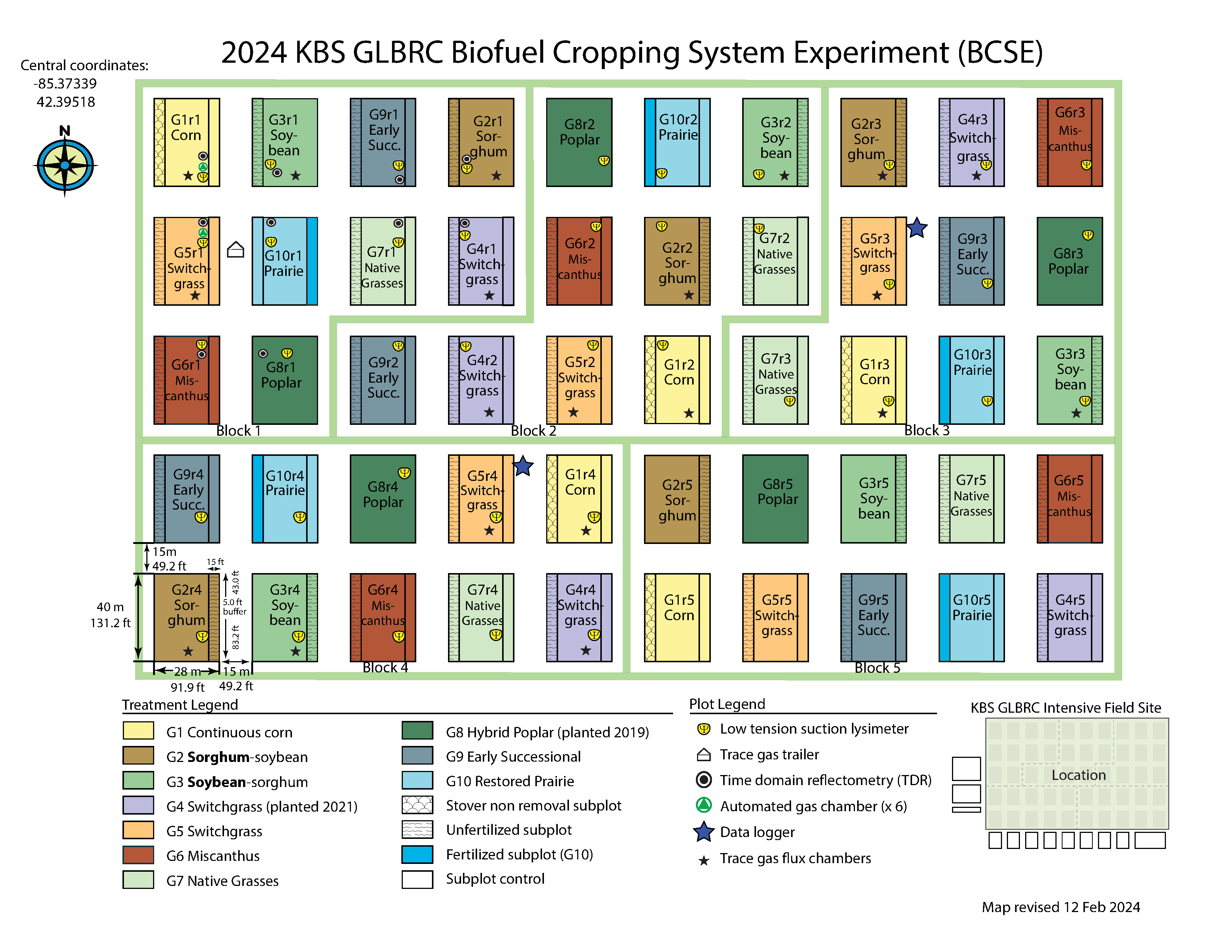The GLBRC Biofuel Cropping System Experiment (BCSE) was established in 2008 to examine the performance of potential bioenergy cropping systems, including assessments of crop yield and quality, microbial-plant interactions, biogeochemical responses, greenhouse gas fluxes, water needs, nutrient leaching to groundwater, and biodiversity responses. Ultimate goals are to model the production efficiencies and environmental impacts of different bioenergy crops.
The BCSE is established as a randomized complete block design that includes 5 replicated blocks of up to 10 cropping systems or treatments, each in 30 x 40 m plots. Current cropping systems include three no-till annual treatments: continuous corn with stover removal (G1) and a sorghum (photoperiod-sensitive ISU hybrid HPS5500)-soybean rotation with both points of entry (G2-G3), and six perennial treatments: switchgrass (G4 (planted in 2021) and G5, Panicum virgatum variety Cave-in-rock), miscanthus (G6, Miscanthus x giganteus), poplar (G8, “NM-6”, Populus nigra x Populus maximowiczii), native grasses (a mix of 4 species; G7), early successional vegetation (G9), and restored prairie (G10). Subplots within treatment plots provide a means for comparing alternative agronomic practices such as stover removal vs. remaining and with vs. without N fertilization. See the plot map for subplot management.
Each BCSE plot contains a semi-permanent set of 3 sampling stations at which most within-plot sampling is performed.
In 2012, the original corn-soybean-canola cropping systems (G2-G4) were discontinued and replaced with continuous corn + cover crop (G2) and a corn-soybean rotation + cover crop (G3-G4, with each entry point represented every year). In 2018, these systems were discontinued: no-till energy sorghum (photoperiod sensitive) was established in G2, and the G3 and G4 plots were fallowed (planted to temporary cover crops). In 2019, G3 was converted to no-till energy sorghum (photoperiod insensitive) with a cover crop. In 2021, G4 was planted to switchgrass and in 2022, G2 and G3 were switched to sorghum-soybean rotations.
An identical experiment was established in 2008 at the Arlington Agricultural Research Station (ARL) in Wisconsin and was retired at the end of the 2017 growing season.
Maps:
- Current
- Archived (2010 onward)
- KBS GLBRC Intensive Field Site
- Sampling Stations
- Rainout shelter subplot locations
Information:
- Publications (search under GLBRC Biofuel Cropping System Experiment)
- Data (search under GLBRC Biofuel Cropping System Experiment)
- Perennial seed species and seeding rates
Major changes in management of treatments:
2022 Treatments G2 and G3 planted to sorghum-soybean rotations with opposing entry points, both with unfertilized subplots.
2021 Treatment G4 planted to switchgrass.
2019 Treatment G3 converted to a no-till, fertilized, energy sorghum (photoperiod insensitive TAM 17900) + cover crop system, with no unfertilized subplot established. Treatment G8 planted with poplar trees (NM-6).
2018 Treatment G2 converted to a no-till, fertilized, energy sorghum (photoperiod sensitive hybrid ES5200) system with an unfertilized subplot; Treatments G3 and G4 retired and fallowed (planted to temporary cover crops); and Treatment G8 left as fallow after winter-time (2017-2018) harvest of poplar trees.
2017 BCSE at the Arlington Agricultural Research Station (ARL) in Wisconsin was retired after harvest.
2014 Treatment G8 poplars harvested and stumps allowed to coppice.
2013 Treatment of cover crops with herbicide begins on the northern 1/3 of the subplot control (stover removed) in G2-G4, with the first yields taken in 2014.
2012 The corn-soybean-canola systems (G2-G4; 2008-2011) were replaced with a continuous corn + cover crop system (G2) and a corn-soybean rotation + cover crop system with two entry points (G3, G4).
